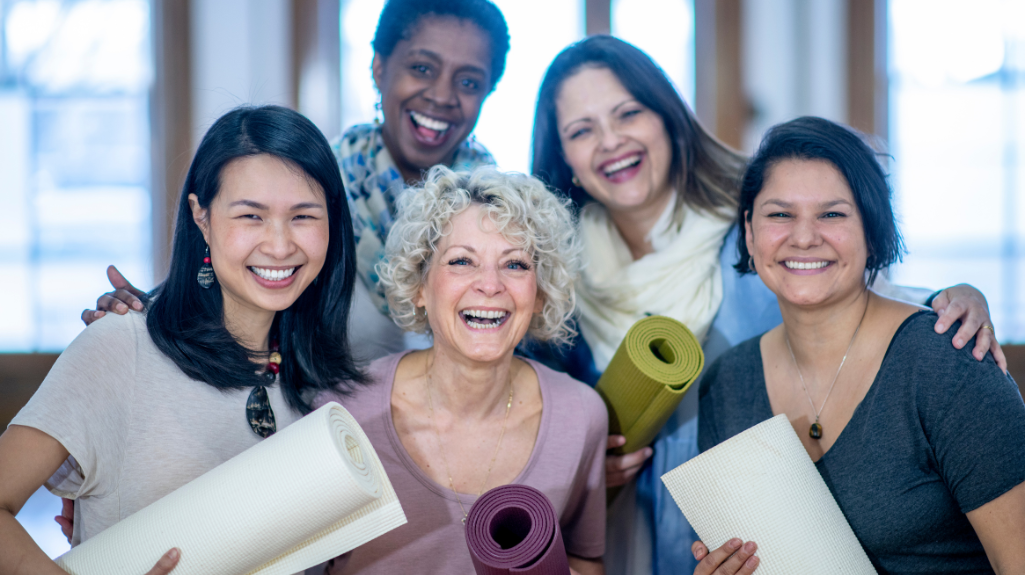Is exercise really that important for midlife women? Who has time for that??
YES! The answer is a resounding YES!
Exercise is important for people of all ages, but it becomes even more critical for women in midlife. Women in their 40s and 50s may begin to experience a variety of physical and hormonal changes that can negatively impact their health and well-being. Fun, right? It’s not all doom and gloom, though because exercise can help mitigate the results and symptoms that come along with some of these changes and improve overall health. The key is to be doing exercise that works with your body, and not against it.
Let’s dive in!

One of the most significant changes women in midlife experience is a decrease in estrogen levels. This decrease can lead to a range of symptoms, including hot flashes, night sweats, and vaginal dryness. And guess what? Exercise can help manage these symptoms!
Midlife women are also at a higher risk for other health conditions, including heart disease, osteoporosis, and type 2 diabetes. Exercise can help reduce the risk of developing these conditions by improving cardiovascular health, increasing bone density, and regulating blood sugar levels.
Regular exercise can also help midlife women maintain a healthy weight. As women age, their metabolism slows down, making it more challenging to maintain a healthy weight.
Good nutrition can help here too, but that’s a topic for another day 😀
Beyond the physical benefits, regular exercise can also improve mental health and cognitive function. Studies have shown that regular exercise can reduce the risk of depression and anxiety, improve memory and concentration, and increase overall cognitive function.
You may be wondering if there are specific exercises that are better for midlife women and the answer is YES!
Here are my suggestions for what to include in your exercise “routine”
Strength/Resistance Training

Strength training is first on my list as it’s the most important and one that we midlife women neglect. We lose muscle mass as we age and we need strength/resistance training to prevent this from happening. Using weights, resistance bands, or bodyweight exercises, can help improve bone density, maintain muscle mass, and boost metabolism. Aim for two full-body strength/resistance sessions per week, targeting major muscle groups like the legs, arms, chest, back, and core.
TIP: Start by doing squats without weights and gradually work up to adding weight or resistance bands. Try push-ups at the wall and as you get stronger, lower the incline to a counter, then to a bench, and finally to the floor.
Cardiovascular Exercise
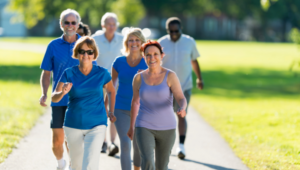
Cardiovascular exercise, such as walking, cycling, swimming, or dancing, can help improve heart health, reduce the risk of chronic diseases, and maintain a healthy weight. Aim for 2 or 3 30-45 minutes sessions of low/moderate-intensity cardio exercise per week. Don’t overdo it here, ladies. Get outside if you can.
TIP: Take short 5-10 minute walk breaks during your day. It all adds up 🙂
Flexibility
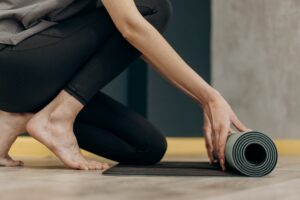
Flexibility exercises like stretching, yoga, pilates, or tai chi can help improve range of motion, reduce the risk of injury, and improve posture. Aim for at least two flexibility sessions per week or better yet, add a daily yoga routine to your repertoire. Short sessions more often can be better than fewer long sessions per week. 10 minutes a day is all you need but be warned, you may want to do more 😉
TIP: If you sit at a desk all day, take regular stretching breaks. Your body will thank you for it.
Mobility
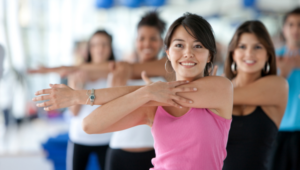
Mobility exercises are essential for midlife women to maintain flexibility, joint health, and overall physical function. As we age, our joints can become stiffer, and our range of motion can decrease. Mobility exercises can help maintain and improve joint health, reduce the risk of injury, and improve posture. Some examples of mobility exercises for midlife women are:
- Shoulder rolls
- Arm circles
- Ankle circles
- Hip circles
- Twists
TIP: Incorporate these moves into a warm-up or cool-down. Many mobility moves will already be included in a yoga class.
Balance

Balance exercises, such as standing on one foot, walking heel to toe, or doing balance poses in yoga, can help reduce the risk of falls and improve overall balance. A bonus of balance work is that it also works the core!
TIP: Try standing on one foot while standing in line at the grocery store. Or do a tree pose and see what kind of looks you get 😜
High-Intensity Interval Training
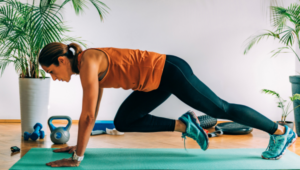
High-Intensity Interval training (HIIT) is a form of exercise that involves short bursts of high-intensity exercise followed by periods of rest. It can help improve cardiovascular health, increase metabolism, and burn calories in a short amount of time. However, it may not be suitable for everyone, especially those with certain health conditions or injuries. Try to keep HIIT to 45 minutes total per week, broken up into a minimum of 2 sessions.
TIP: Don’t complicate it. Make the exercise simple but intense enough to get the heart rate up.
Overall, exercise is essential for midlife women to maintain their health and well-being. Incorporating regular physical activity into their daily routine can help manage symptoms of menopause, reduce the risk of chronic conditions, maintain a healthy weight, and improve mental health and cognitive function. Bonus – Exercise also helps improve sleep when done early in the day…zzzzz!
Need some help getting started?
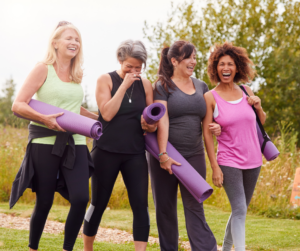
If you would like some guidance on what to do and how to incorporate more movement into your day, I invite you to check out my upcoming 7-day yoga/movement challenge for midlife women – CLICK HERE

